This time, the F10 with N53 has encountered some troubles.
The owner of the vehicle decided to put in order the engine of the car. The NOx system was repaired. Spark plugs and ignition coils were replaced. Spark plugs and ignition coils: NGK. Replaced in a reliable service center. Everything should be in order with this for 100%!
Something is still not right.
The error message 143101 stubbornly appears in the DME error message memory, and the Stratified charge is switched off. What could be the problem?
143101 Rough running, stratified-charge operation: increased rough running in stratified-charge operation
What is said in the material intended for BMW dealers regarding such issues?
In the notes, it is mentioned: the engine work temperature should be above 70oC; the error message recording obstacles depend on RPM. That’s it.

Interesting manufacturer attitude: if the customer is not especially complaining – ignore. Each person with some technical knowledge nows – misfires not only increase the fuel consumption (due to the cylinder “not performing” and due to switched off Stratified charge) but the CO catalytic converters are damaged too. The catalytic converters cost several thousand EUR. If the owner of the vehicle pays for it himself – not a big deal, huh?
And more to be considered: unlike the E series (for the E series, the number of this error message is 3104), the F series tries to hide all problems as much as possible. This error message 143101 DME records very rarely, only in cases when the engine already shivers strongly. In the case of the E series, there was an opposite problem – quite often, for N53 series engines, this error message was recorded as unjustified.
Obviously, this time the problem is serious.
We start the diagnostics of the problem.
Inspection of misfires gives interesting information. After driving for 4 .. 5 minutes (the engine warmed up; directly after deleting the error messages and restoring the Stratified charge), data of the actual session:
a. misfires in all cylinders, typically 4 .. 9 values;
b. after 5 minutes, the Stratified charge is switched off.
In addition, long-term data indicate 2 .. 4 units in all cylinders!
The conclusion is simple: this problem affects ALL cylinders; it is stable!
In addition, the long-term counters say that during the last driving sessions, the number of misfires in each cylinder was impressive (at least 30 .. 50).
What could be broken down in all cylinders?
A moment ago, the VANOS of the vehicle was repaired (solenoids were replaced – they were clogged). Maybe VANOS jitters? We checked VANOS – everything was perfect.
Maybe the Rail fuel pressure shivers? Wed check both LP and Rail pressure – they are correct and stable.
Coupling rings are not installed on injectors (I have never had problems because of this)? No, the injectors are installed correctly.
All other live data indicate correct values.
Dead end.
Despite the customer’s claim that the installer of spark plugs and ignition coils can be trusted 100%, I still asked to check the code of the installed ignition coils. Answer: the NGK 48147 coils are installed.
Let’s see what the catalogs say.!
https://alvadi.eu/kataloog/varuosa/13389687/11068#!product-tab-comp2
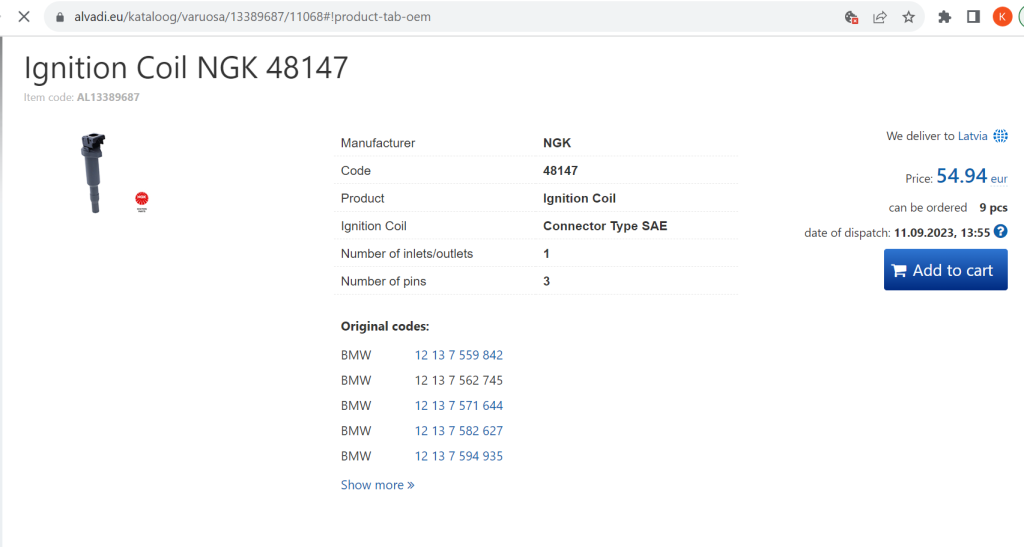
BMW codes are correct; everyone can check them via reaOEM.com
Here, we can also make sure that these ignition coils are intended only for N43/N53 series engines.
But let’s see, what does this online catalog says:
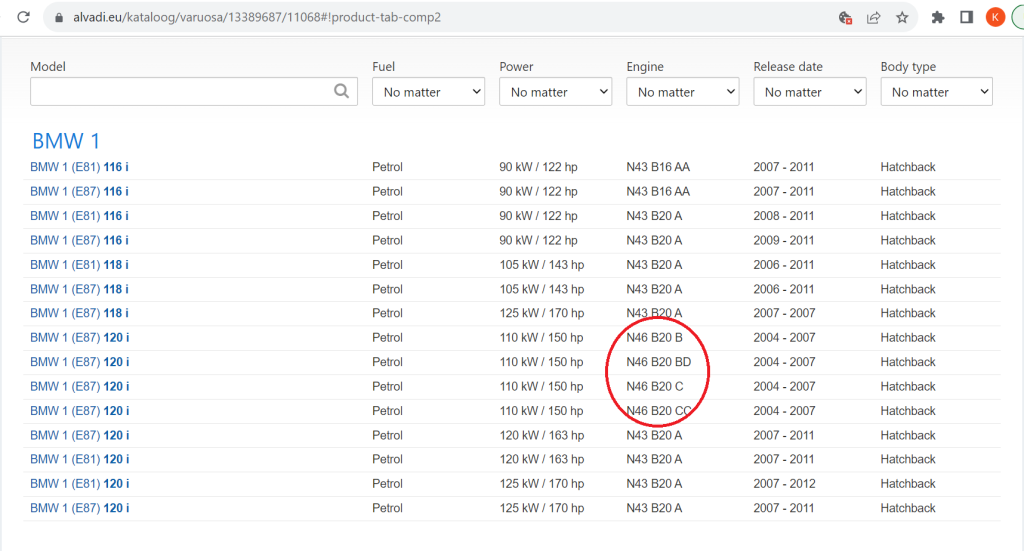
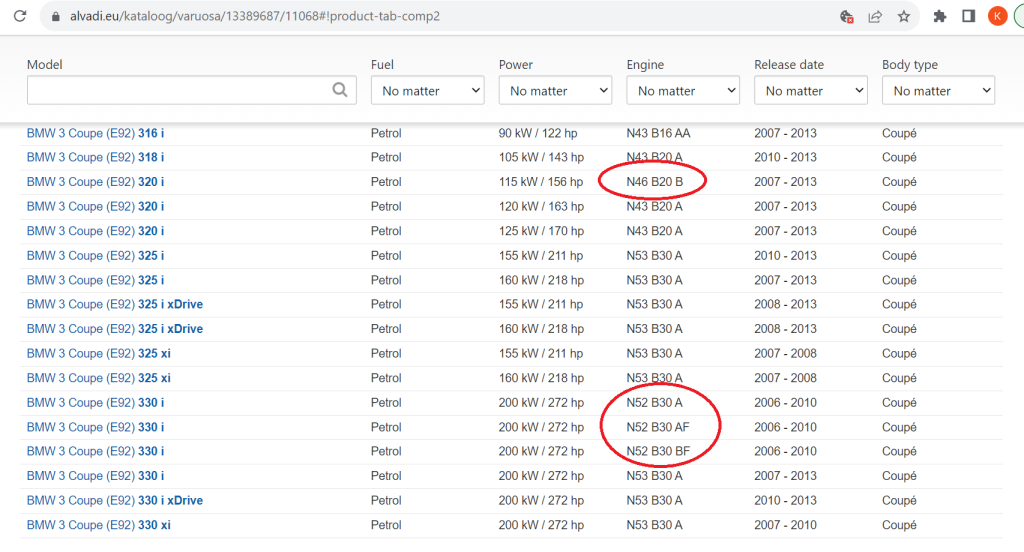
How is that possible? N46? N52? These are not even DI engines! These are old-generation port injection engines! I checked 5+ available online catalogs in which this ignition coil is listed. In all of them, the N46 and N52 engines are compatible! You will say – it is not professional? True!
Let’s check the NGK Online catalogue:
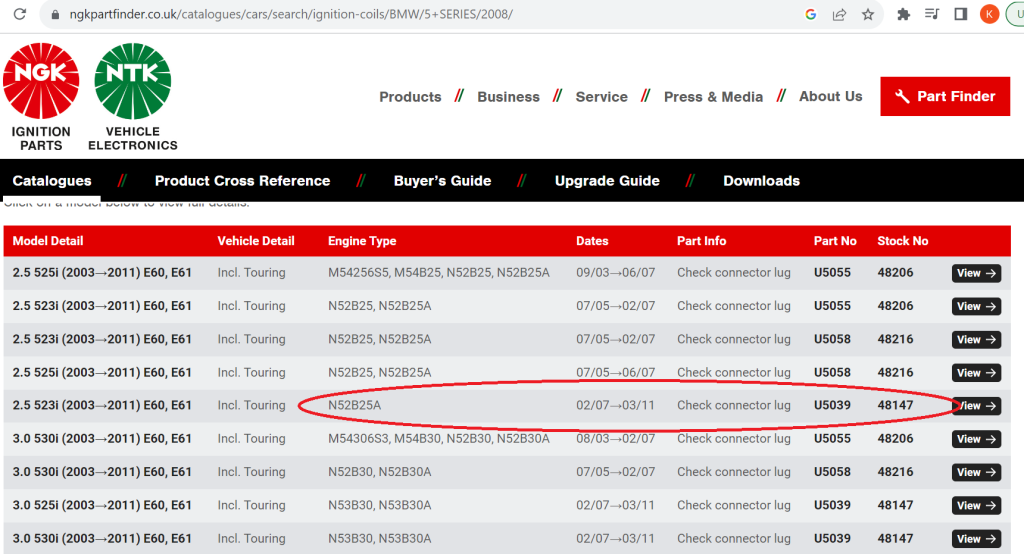
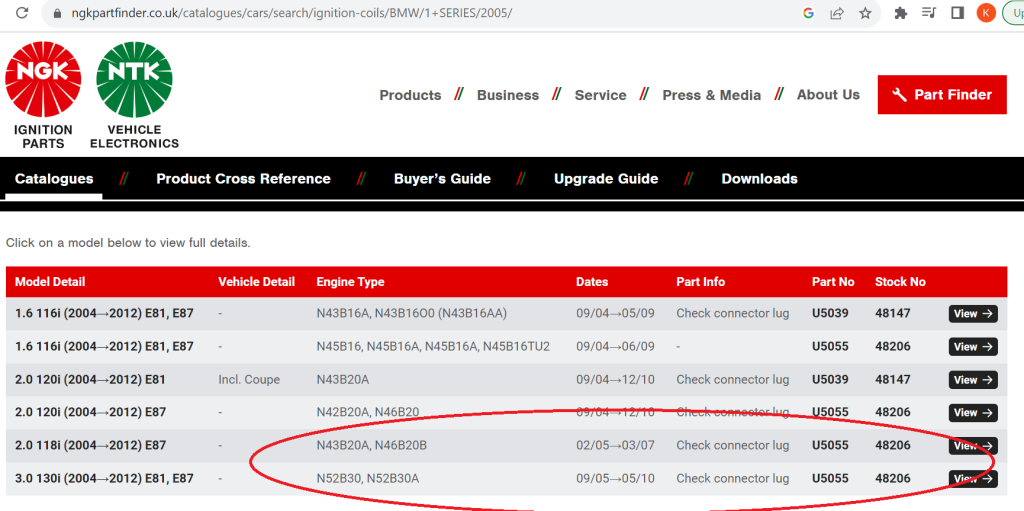
Here, this ignition coil is suitable for N52. For N43/N53, N45, and N46, the same coil can be inserted… It looks like NGK has no clue what and to whom they are selling! What are the differences between ignition coils? Read here.
I asked the customer to install Bosch 0 221 504 471, intended for N53.
I got the message from the customer – after a half-an-hour drive, the following misfire counters are recorded:
Cylinder 1 : 4 misfires
Cylinder 2 : 4 misfires
Cylinder 3 : 5 misfires
Cylinder 4 : 0 misfires
Cylinder 5 : 21 misfires
Cylinder 6 : 0 misfires
I see a fundamental upgrade!
a. the engine was using Stratified charge for half an hour;
b. the “perfect” cylinders (No.4 and No.6) have appeared;
c. 4 .. 5 misfires during 30 minutes is an acceptable reading (taking into account that the engine hasn’t used Stratified charge regularly for a long time and only now starts to perform the injector measurements);
d. with such a density of misfires, even in case of one-hour driving sessions, the long-term counters of 5 from 6 cylinders will be 0 (before replacing the ignition coils, these counters were 2 .. 4, which means indicated an average of at least 30 .. 50 misfires in each session);
e. the error message regarding the Rough run is not recorded.
Yes, I know that 99% of service workers work with “codes”; to them, only the last one applies. The error messages are/are not present; there are no other arguments. But live data gives much more information! Yes, cylinder No.5 has increased misfire density. But there is no need to panic. It is possible that the flowrate of the injector is reduced in some driving conditions. Due to that, the fuel mixture in this cylinder is leaner; in other cylinders – richer than it should be. The ideal performance of both other cylinders (No.4 and No.6) indicates that indirectly.
4 .. 5 misfires during half-an-hour vs 4 .. 9 misfires during 5 minutes means around 8(!) times lower average misfire density; this is a fundamental upgrade!
What to do with the problematic cylinder No.5? Perform longer drives to allow DME to adapt the injectors in all possible driving conditions. As indicated by BMW, the creation of the adaptations can take up to 10.000 km!
If, even after a longer time, cylinder No.5 will stubbornly indicate some problems – the injector will need to be replaced. It is possible that it leaks in some exact mode. Or – the injector has an incorrect beam (fuel hits the spark plug and drowns it, or vice versa – the fuel is injected too far from the spark).
In any case – the mystery of all cylinder damage is solved.
